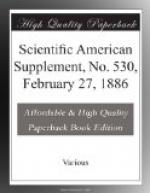In addition to these considerations, it was thought useful to investigate the quantity of water consumed in the case of those engines which used steam. The experiments made on this point showed as the consumption of water:
Gallons per mile. Rowan 0.75 Compressed air 1.06 Wilkinson 5.89 Krauss 6.52
Thus, owing to the large proportion of water returned from the condenser to the tanks, the Rowan actually used less water than the compressed air engine.
CONCLUSION.
The general conclusion to which these experiments bring us is that, undoubtedly, if it could certainly be relied upon, the electric car would be the preferable form of tramway motor in towns, because it is simply a self-contained ordinary tram-car, and in a town the service requires a number of separate cars, occupying as small a space each as is compatible with accommodating the passengers, and which follow each other at rapid intervals.
But the practicability and the economy of a system of electric tram-cars has yet to be proved; for the experiments at Antwerp, while they show the perfection of the electric car as a means of conveyance, have not yet finally determined all the questions which arise in the consideration of the subject. For instance, with regard to economy, the engine employed to generate the electricity was not in thoroughly good order, and from its being used to do other work than charging the accumulators of the tram-car, the consumption of fuel had to be to some extent estimated. In the next place, the durability of the accumulators is still to be ascertained; upon this much of the economy would depend. And in addition to this question, there is also that of the durability of parts of the machinery if exposed to dust and mud.
After the electric car, there is no question but that at the Antwerp Exhibition the most taking of the tramway motors was the Rowan, which was very economical in fuel, quite free from the appearance of steam, and very convenient and manageable.
The economy of the Rowan motor arises in a large degree from the extent of its condensing power, by means of which a considerable supply of warm water is constantly supplied for use in the boiler, and consequently the quantity of water which has to be carried is lessened, and the fuel is economized.
Independently, however, of its convenience as a motor for tramways in towns, the Rowan machine has been adapted on the Continent to the conveyance of goods as well as passenger traffic on light branch railways, and fitted to pass over curves of 50 feet radius, and up gradients of 1:10.




